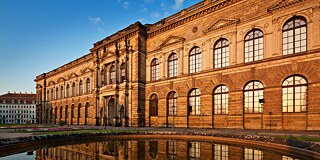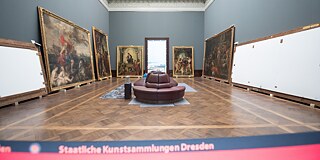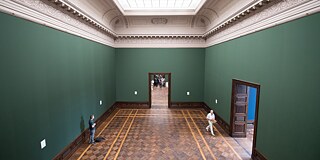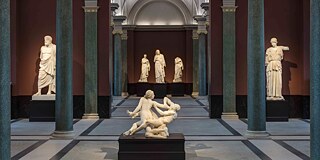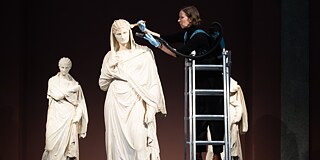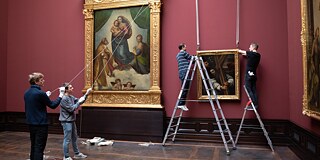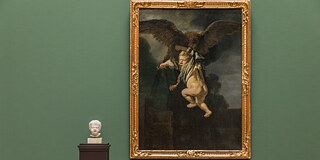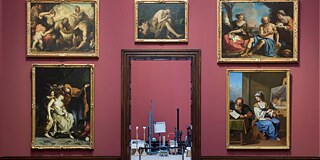Culture in the Quarter
Dresden places its treasures in a new light
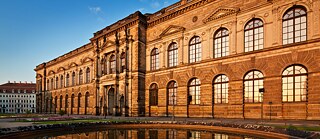
The Old Master Picture Gallery in the Dresden Zwinger, the palace that serves as an art museum, is celebrating its reopening – and thrilling visitors with a skillful surprise: the exhibition has been rearranged, allowing for a new perspective on its well-known masterpieces.
By Andreas Platthaus
This year Dresden is celebrating the end of a seven-year renovation during which the most significant works of art in the Old Masters Picture Gallery were inaccessible to the public. But now the Old Masters collection in the Zwinger’s Semper Wing is on display again in all its glory, and features four of the city’s leading ladies: Raphael’s Sistine Madonna and three antique marble sculptures known collectively as the Herculaneum Women. Purchased by King Augustus III, all travelled to Sachsen in the 18th century. Though they cost the monarch a fortune at the time, the investment has paid great dividends over the years by helping Dresden maintain its reputation as a city of culture, thanks in no small part to its valuable art collections.
In the mid-19th century, architect Gottfried Semper designed a new building to house Dresden’s artwork: the Semper Gallery. Although he was forced to flee the city as a failed political revolutionary while the wing was still under construction in 1849, Semper left behind an eye-catching edifice in his first museum. Taking the Italian architecture of Rome and Florence as his inspiration, the architecht created a palace of the arts intended to outshine the neighbouring royal palace. The three Herculaneum Women graced the first floor, while the Sistine Madonna as Queen of Heaven awaited admirers one floor up. By 1881 though, the four women were forced to part ways when the collection of antique art was transferred to a new museum, the Albertinum. Military objects from the Dresden Armoury took the Herculaneum Women’s places, as beauty gave way to the art of war.
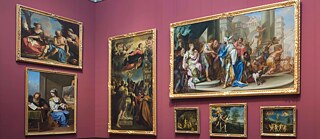
Antique sculptures again dance in a play of light
Now the Herculaneum Women have returned triumphant, together with 120 antique sculptures from the Saxony princes’ famed collection, in a comeback made possible by much needed upgrades to the Semper Gallery. The museum’s director, Viennese art historian Stephan Koja, took advantage of the renovations and rearranged the holdings. In the intervening years, the armoury and weapons collection had withdrawn into the neighbouring palace, and now the sculptures have taken up their rightful place in the gallery designed especially for them. Semper used natural light to show them off to their best advantage. He installed rows of tall windows along the two long sides of the gallery on the first floor, so the light that played over the sculptures shifted with the changing position of the sun in a spectacle no one has seen in 140 years, since the light was dimmed significantly for the armoury exhibits.
Since natural sunlight is not a particularly reliable source of illumination in Germany, the museum has turned to some more modern lighting techniques as well. Visitors walking through the huge gallery may well feel like they are moving across a stage on which each piece is bathed in its own globe of light.
Enlightening dramaturgy
Today, art lovers no longer enter the sculpture gallery through the portal Semper envisioned. They walk up from below via a staircase from a below-ground passageway into the gallery. This approach from darkness into light is a masterpiece of dramaturgy in itself, as the antique sculptures appear as far-away visions on the horizon as visitors make their way up the steps. Like queens, the Herculaneum Women reign supreme in their private niche at the end of the gallery, while the Sistine Madonna hangs regally one floor above.
Koja’s decision to integrate sculpture into the Picture Gallery decisively changed the dramaturgy of a perusal of the upper floor as well. Discovering these traditionally isolated masterpieces in a new context is enlightening, as they reference the content of the paintings as well. The forms of gods and goddesses are juxtaposed with paintings of the same; men of sorrows stand next to renderings of the Passion, and busts of rulers share space with portraits of sovereigns. The great Dresden collection of Old Masters has become an even more powerful school of seeing and understanding, including the parallels drawn between the Sistine Madonna and the Herculaneum Women through their vertical juxtaposition, though it is invisible to visitors.
In addition to the completely new arrangement of the collection, many pieces on loan have come home to Dresden, including a number of medieval wooden sculptures on display in the Schlossbergmuseum (Castle Hill Museum) in Chemnitz. Now they have returned to the Semper Gallery to complete an impressive tapestry cycle from the 16th century. In return, works on loan to Dresden have found their way back to the nearby city of Chemnitz, where the art museum with its fascinating collection of modern works is scheduled for renovation. Plans include a new gallery for pieces from the early 20th century, such as paintings by Max Liebermann and Max Beckmann.
